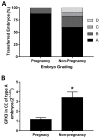GPX3 Overexpression in Cumulus Cells Entails a Poor Prognosis for Uterine Implantation of Morphotype A Embryos
- PMID: 36138840
- PMCID: PMC9495337
- DOI: 10.3390/biology11091361
GPX3 Overexpression in Cumulus Cells Entails a Poor Prognosis for Uterine Implantation of Morphotype A Embryos
Abstract
Morphological embryo quality is an accurate prognostic tool for the success of assisted reproduction implantation, although complete certainty cannot be guaranteed. The transcriptome of the cumulus cells could be monitored as a faithful reflex of the physiological state of the oocytes, given the molecular crosstalk between both types of cells. Here, we compare the expression of specific genes related to oocyte competence, such as hyaluronic acid synthase 2 (HAS2), cell division control protein 42 (CDC42), connexin 43 (CX43), and glutathione peroxidase 3 (GPX3), in cumulus cells from implanted versus non-implanted embryos in 25 women, using RT-qPCR. After embryo transfer, two cohorts were differentiated: the pregnant group (women with the implantation of 100% of embryos transferred) versus the non-pregnant group (with an absence of embryo implantation), aiming to compare the possible differential expression of the selected genes in the cumulus cells of embryos from each group. HAS2, CDC42 and CX43 did not reveal differential expression between the two cohorts. However, GPX3 showed significantly reduced expression in the cumulus belonging to the pregnant group. Interestingly, even cumulus cells belonging only to morphotype A embryos showed a significantly lower expression of GPX3 in the pregnancy group. GPX3 overexpression in cumulus cells could be a poor prognostic indicator of implantation, discriminating beyond the capacity of the morphokinetic score. Unveiling the cumulus transcriptome could improve successful implantation in assisted reproduction treatments.
Keywords: GPX3; cumulus cells; implantation; infertility; oocyte competence; transcriptome.
Conflict of interest statement
The authors declare no conflict of interest.
Figures


Similar articles
-
RUNX2, GPX3 and PTX3 gene expression profiling in cumulus cells are reflective oocyte/embryo competence and potentially reliable predictors of embryo developmental competence in PCOS patients.Reprod Biol Endocrinol. 2013 Nov 26;11:109. doi: 10.1186/1477-7827-11-109. Reprod Biol Endocrinol. 2013. PMID: 24279306 Free PMC article.
-
Human cumulus granulosa cell gene expression: a predictor of fertilization and embryo selection in women undergoing IVF.Hum Reprod. 2004 Dec;19(12):2869-74. doi: 10.1093/humrep/deh535. Epub 2004 Oct 7. Hum Reprod. 2004. PMID: 15471935
-
A pre-in vitro maturation medium containing cumulus oocyte complex ligand-receptor signaling molecules maintains meiotic arrest, supports the cumulus oocyte complex and improves oocyte developmental competence.Mol Hum Reprod. 2017 Sep 1;23(9):594-606. doi: 10.1093/molehr/gax032. Mol Hum Reprod. 2017. PMID: 28586460
-
PCOS and Role of Cumulus Gene Expression in Assessing Oocytes Quality.Front Endocrinol (Lausanne). 2022 May 26;13:843867. doi: 10.3389/fendo.2022.843867. eCollection 2022. Front Endocrinol (Lausanne). 2022. PMID: 35721714 Free PMC article. Review.
-
CUMULUS CELL GENES AS POTENTIAL BIOMARKERS OF OOCYTE AND EMBRYO DEVELOPMENTAL COMPETENCE.Fiziol Zh (1994). 2016;62(1):107-13. doi: 10.15407/fz62.01.107. Fiziol Zh (1994). 2016. PMID: 29537212 Review.
Cited by
-
Multi-Omics Reveal the Metabolic Changes in Cumulus Cells During Aging.Cell Prolif. 2025 Aug;58(8):e70014. doi: 10.1111/cpr.70014. Epub 2025 Mar 5. Cell Prolif. 2025. PMID: 40044606 Free PMC article.
References
-
- Krisher R.L., Schlenker T. Culture of Human Preimplantation Embryos in a Clinical ART Setting. Methods Mol. Biol. 2019;2006:355–371. - PubMed
-
- Ardoy M., Caderón G., Cuadros J., Figueroa M.J., Herrer R., Moreno J.M., Ortiz A., Prados F., Rodríguez L., Pedro J.S., et al. Criterios ASEBIR de Valoración Morfológica de Oocitos, Embriones Tempranos y Blastocistos Humanos. 3rd ed. Góbalo. Agencia Creativa Digital; Madrid, Spain: 2015. Cuadernos de Embriología Clínica.
Grants and funding
- Arts. 68/83 LOU number 0904/0401/Fundación Guadalquivir de Investigación Biomédica
- CTS160/Program from the Andalusian Government PAIDI
- VI PPIT-US/I.B. was supported by the VI Program of Inner Initiative for Research and Transfer of University of Seville [VI PPIT-US]
- RD12/0043/0012/N.A.-S. was supported by the National Net RETICEF for Aging Studies from the Instituto de Salud Carlos III, Spanish Ministerio de Ciencia e Innovación
LinkOut - more resources
Full Text Sources
Medical
Miscellaneous

